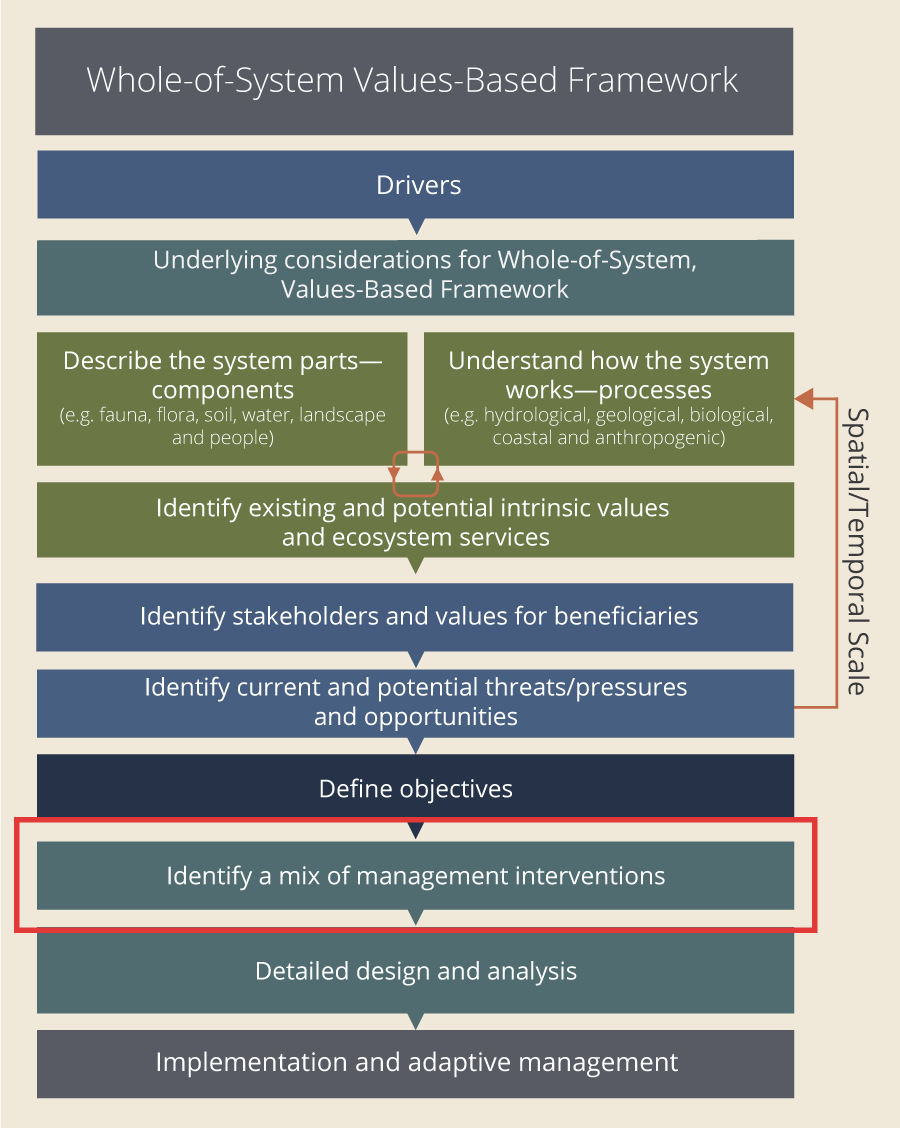Management interventions can be categorised under six different themes:
Plan/prioritise management needs
A range of tools and methods are available for assessing and prioritising management interventions. The following factors should be considered when planning and carrying out the prioritisation process for identifying the mix of management interventions:
- engage relevant beneficiaries and other stakeholders throughout the planning and prioritisation process to ensure that the management needs of those who use and value the system are included in planning and prioritisation (e.g. what do the beneficiaries value about this system? How will values be incorporated into management interventions?)
- have appropriate specialist advice and legal obligations (e.g. permits) been considered? Are these potential constraints to the proposed management interventions?
- weight competing priorities to identify management interventions/opportunities to maximise benefits for the system and the beneficiaries who rely on it (e.g. how will the social, cultural and economic values of beneficiaries be considered when weighting for high-value biophysical benefits?)
- identify the risk(s) associated with the prioritisation process and/or management project/intervention, including potential trade-offs or negative impacts to stakeholders (e.g. what impact will prioritising conservation outcomes for the system have on the people who use the system for extractive purposes?)
- consider the feasibility (e.g. whether the project can be done) and practicality (e.g. whether the project is appropriate to be done) of management interventions/projects (e.g. are the proposed management needs and interventions appropriate to be done in this location at this time?)
- consider the length of time (i.e. longevity) that a project and/or management interventions are intended to last (e.g. how long will the project need to last in order to achieve the desired outcomes?)
- what maintenance and monitoring will need to be in place to achieve the objectives of the project?
- outline costings associated with the project/management interventions, including available funding sources (e.g. how much investment is required to address the management needs and are there management interventions or projects that are more cost-effective and can achieve similar results?)
- identify and outline the technology required to help achieve objectives (e.g. what technology is required to complete this project and is it readily available?)
- detail the expectations for the project/management intervention, including expectations from funders, public perception, accountability/responsibility for management actions/outcomes (e.g. who will fund the project, who will complete the work, what will the beneficiaries expect from the outcomes of this project?)
- determine the scale of the project and associated management interventions (e.g. fine scale (site-specific) or landscape scale). What scale is required to achieve these objectives and what will the impacts be to the broader system?
- develop a plan to document all aspects of the Framework, and continually update as new information becomes available.
Last updated: 19 January 2023
This page should be cited as:
Department of Environment, Science and Innovation, Queensland (2023) Identify a mix of management interventions, WetlandInfo website, accessed 8 May 2025. Available at: https://wetlandinfo.des.qld.gov.au/wetlands/management/whole-system-values-framework/intervention-options.html

 — Department of the Environment, Tourism, Science and Innovation
— Department of the Environment, Tourism, Science and Innovation


